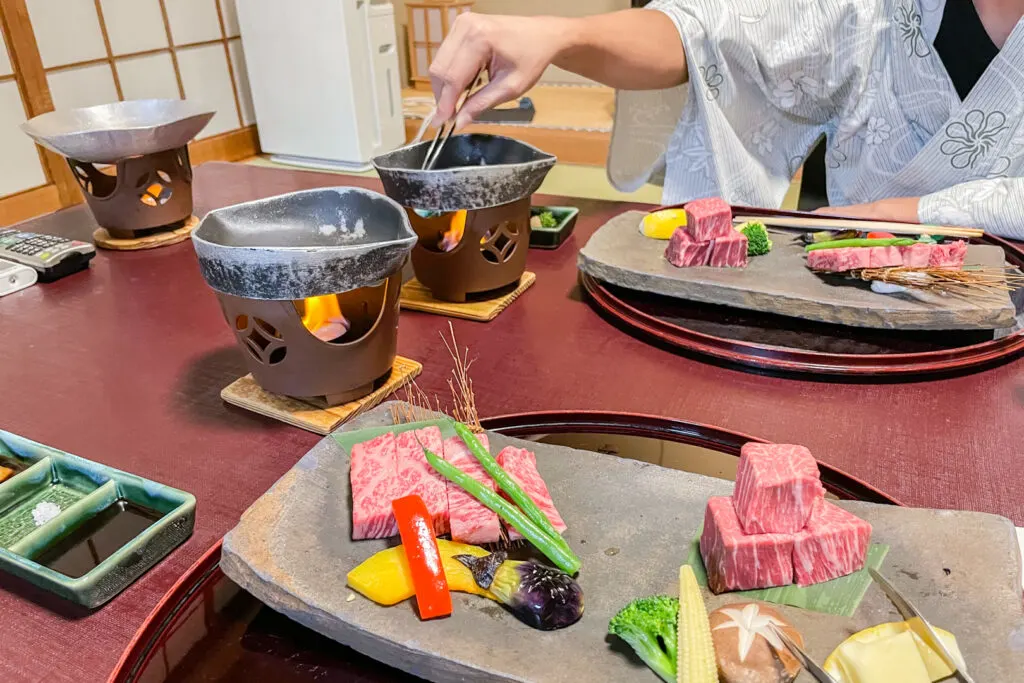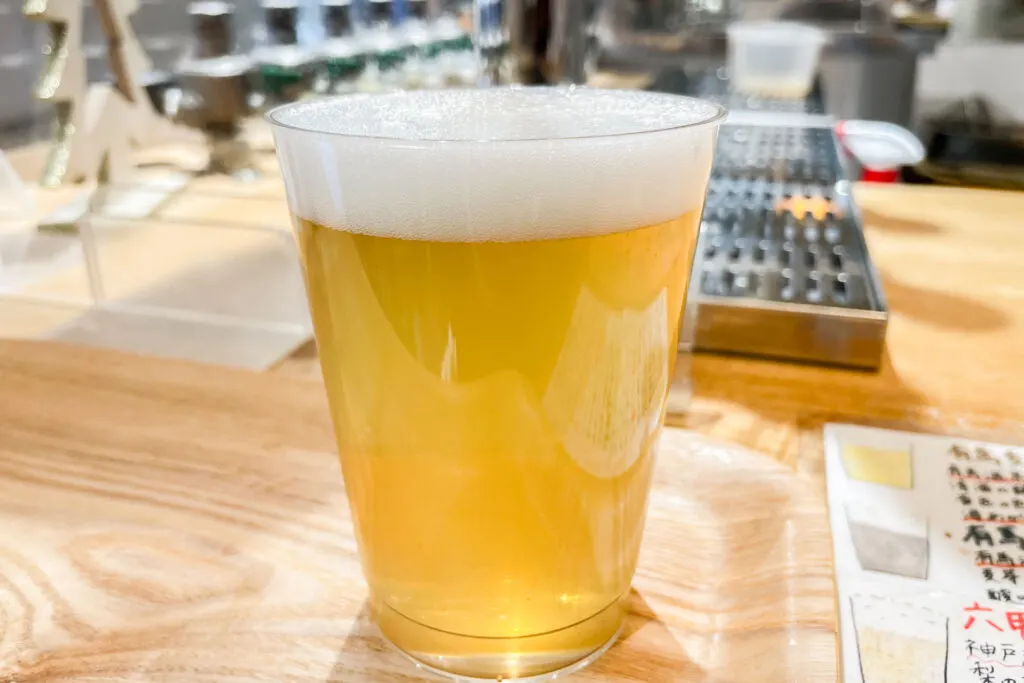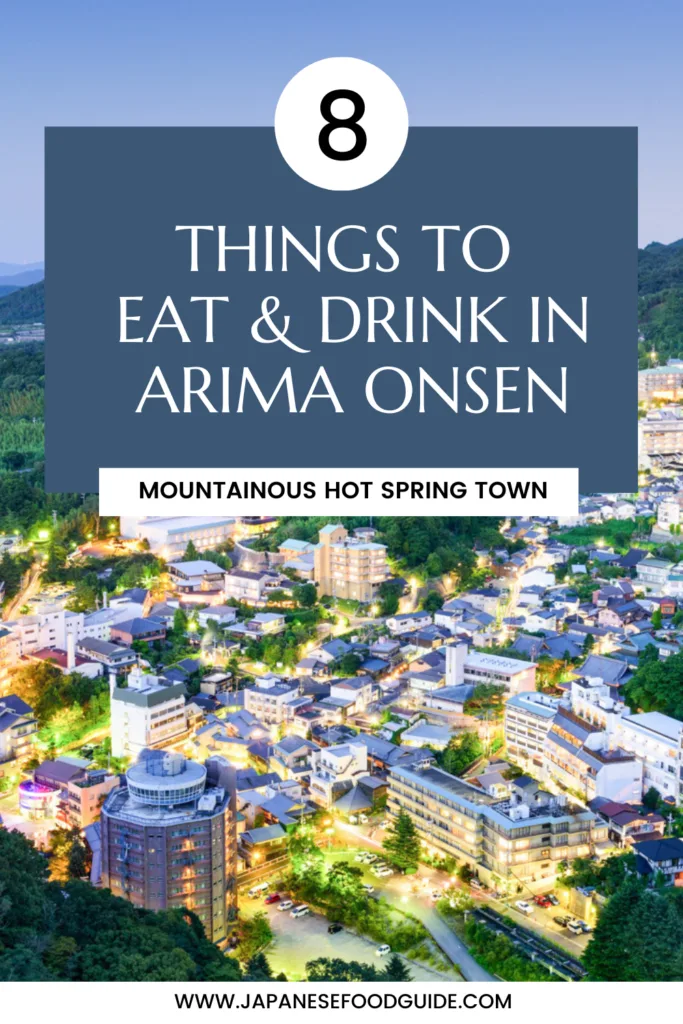Arima Onsen (有馬温泉, ありまおんせん) is a hot spring resort town nestled in the mountains of Kobe that is famous for two things: relaxing in onsen (as per the name, of course) and filling up on delicious food.
In fact, tabearuki (食べ歩き, たべあるき) is quite common, which means walking around town while eating a portable snack or two.
If you’re wondering what kind of food Arima Onsen has to offer, here’s what JFG recommends.

Table of Contents
Kobe Beef (神戸牛, こうべぎゅう)
This shouldn’t be surprising given that Arima Onsen is in Kobe, but if you’re looking to try this famous kind of beef, called Kōbe Gyū (神戸牛, こうべぎゅう) in Japanese, Arima Onsen is a great place to visit as you can enjoy it in many ways in one go.
There are plenty of restaurants and stalls that serve Kobe beef but my recommendation is to stay at a ryokan where you can be served a full-course dinner featuring this melt-in-your-mouth, buttery meat. I’m talking Kobe beef shabu shabu, yakiniku, and the list goes on.

Tansan Senbei (炭酸せんべい, たんさんせんべい)
There are tons of different kinds of senbei (せんべい), or rice crackers, throughout Japan but what makes the senbei in Arima Onsen unique is that it’s made of carbonated water, called tansan (炭酸, たんさん) in Japanese. This is supposed to make the cracker more crisp and airy than your average senbei, and after trying it, I have to say that there is a difference!
Tansan senbei also comes in a range of flavors, such as ginger, peanut, plum and shiso, and sesame seed, just to list a few. Some are also filled with cream like strawberry or vanilla.

I ate so many of these when I visited Arima Onsen and in several ways, such as freshly dipped in chocolate and in gelato, but my favorite was definitely from 湯の花堂本舗太閤通り店 (Yunohanado Honpo), a shop that has a seven-decade-long history. Here you can try their ‘Freshly baked “Rare Tansan Senbei”’ or Nama Tansan Senbei (なま炭酸せんべい, なまたんさんせんべい) immediately after it’s made —I’m talking within five seconds.
Do not take a picture, do not hesitate or think that it might be too hot. If you eat it within five seconds of getting it, you’ll be rewarded with a chewy taste similar to biting into a fresh crepe or a thin, soft cookie straight from the oven. Wait any longer and the senbei will harden into the typical Tansan Senbei commonly found at stores in Arima Onsen, so it’s like experiencing two textures at once while you eat.

You might see a line if you go there to try their Tansan Senbei but don’t worry, the line moves very fast. Note that you get two senbei, so don’t be afraid to quickly bite into the first while you wait for the second one.
Another nice place to try Tansan Senbei is Arima Gelateria Stagione. They boast around 18 flavors of gelato, such as Roasted Tea, Butter Caramel, Arima Cider and Lemon, as well as seasonal specialties. Their range of gelatos are topped with a Tansan Senbei when served, so it’s a nice way to try two delicious things famous in Arima Onsen at once.
This gelato store also ranked 38 in the 2022 Gelato Festival World Ranking, which is not a surprise when considering how well-crafted and delicious their gelato is.

Manju (饅頭, まんじゅう)
Manjū, a type of Japanese steamed rice cake with filling, is a popular dessert in Arima Onsen and is sold at various souvenir shops. For instance, 三ツ森本舗 (Mitsumori Honten) has freshly steamed manju called Yoito Manjū (よい温まんじゅう). This manju’s dough contains brown sugar and yam (山芋, やまいも), giving it a beautiful brown color and fluffy texture. It’s delicious and perfect to have on a crisp winter day.

But there’s one particular kind of fresh manju that I haven’t seen anywhere else in Japan —Sake Manjū (酒饅頭, さけまんじゅう). Just as the name implies, this manju is steamed in sake. The outside of the piping hot manju is soft with a hint of sake to it that contrasts nicely with the sweet and smooth red bean paste filling called koshian (こしあん), making it a unique food experience.

You can find Sake Manju at 和菓子工坊 ありま (Wagashi Koubou Arima). While you’re there, you may want to try their famous Karintō Manjū (かりんとう饅頭). The outside has the sweet taste and crisp texture of karintō, a deep-fried Japanese stick-like snack made of flour and brown sugar, while the inside is packed to the brim with hot koshian.

Dango (団子, だんご)
Dango are glutinous rice dumplings that are commonly found in grocery stores or shops in tourist areas. It isn’t specific to Arima Onsen but I thought I would include it on the list because the dango I had at one particular store, Himitsu no Mitarashi Dango (秘密のみたらし団子), was amazing. My husband, who has been eating dango since he was a child, said it was among the best he has ever had.
The store has several different types of flavors for the dango so it was hard to choose but we decided to go with Mitarashi Kinako Shitate (みたらしきな粉仕立て, みたらしきなこしたて). The skewered balls of dango were cooked perfectly right in front of us with a blowtorch before being placed on a tray with kinako on it (roasted soybean flour). It was then slathered in a golden brown soy sauce glaze that had just the right amount of sweetness and topped with small bits of butter from Hokkaido. This dango was absolutely glorious and I highly recommend trying one.

Croquettes (コロッケ)
Croquettes can be found almost everywhere in Japan, from convenience stores to udon shops, but the croquettes at Takenaka Nikuten (竹中肉店, たけなかにくてん) are packed with a mix of Kobe beef and other Kuroge wagyū (Japanese black beef) inside.
Their croquettes have a really nice crunch on the outside while the inside is juicy and packed with flavor. Personally, it was a little too heavy for me but that made it perfect for sharing with my toddler and meat-loving husband who thoroughly enjoyed it.

Arima Beer (有馬ビール)
While you enjoy your croquette, why not get a craft beer brewed at Arima Onsen? There are several flavors to enjoy from different stores. After buying my croquette, I decided to grab a takeaway Pear-flavored beer from a craft beer bar called Arima Cinq (有馬Cinq) while my toddler had freshly made apple juice with slices of apple in it.
The beer was light but didn’t skimp on flavor with just the right amount of pear. Before I realized it, it was gone. If it wasn’t winter, I probably would have grabbed another one but my hands were a bit too cold. My daughter also quickly downed her drink and wanted more!
We also got bottles of Arima Bakushu (有馬麦酒, ありまばくしゅ) Japanese ale and Black ale to enjoy at home from the souvenir store at our ryokan and were pleased with each one.

Arima Cider Teppo Water (ありまサイダー てっぽう水)
If you’re not a fan of beer and are looking for something carbonated, then I recommend grabbing some Arima Cider. This is sold at various stores in glass bottles with a retro-style label that perfectly depicts the history of this drink that has been around since the Showa period. Supposedly, this cider was the first made in Japan!
It’s quite refreshing, so it would also be perfect to pair with something heavy like croquettes as you eat while walking around town.

Boar Meat Buns (イノシシ肉まん, いのししにくまん)
For those of you who are adventurous eaters, perhaps you’d be interested in some Boar Meat Buns or Inoshishi Nikuman (イノシシ肉まん) from Arima An (有馬庵, ありまあん), which are steamed buns containing 100% boar meat.
I have not tried these so I cannot vouch for the taste but I’ve read on Japanese review sites that it doesn’t taste gamey. If you do try it, let me know what you think!

If you decide to head to Arima Onsen and enjoy some (or all) of these types of food, I recommend going early in the day as many shops where you can get snacks (such as croquettes) tend to close from around noon to 2 PM for lunch. Some items might sell out as well.
And to help make tabearuki easier, you might want to use this Google Map, which has all the stores listed above on it.
For more Area & Restaurant Guides in Japan, click here.
Featured Image /via Getty Images.
Pin me for later

Kay is a Canadian freelance translator and writer who has been in Japan for more than a decade. Having lived in the Chugoku, Kanto, and now the Kansai regions, she hopes to share their various local cuisine on JFG.
She also writes about her experiences being a mother in Japan on her website, Tiny Tot in Tokyo.

Jenni
Thursday 27th of April 2023
Arima Onsen is great! I’ll be trying the inoshishi nikuman next time I go. 🤤